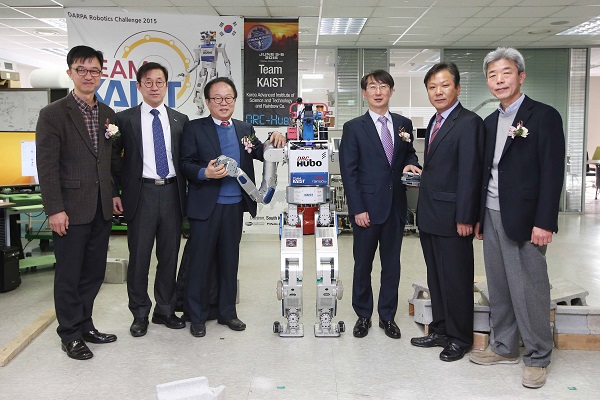policy

(Photo from left: Kyong-Hoon Kim from Korea Evaluation Institute of Industrial Technology, Vice President of Research at KAIST Hee-Yoon Lee, Director Oh, Jong-Hwan Kim at the Ministry of Trade, Industry and Energy, President Ki-Han Park at the Korea Institute for Robot Industry Advancement, and Dean of KAIST Institute Yun Chol Chung.)
KAIST opened its Humanoid Robot Research Center on January 19 at the KAIST Institute. Endorsed by the Ministry of Trade, Industry and Energy with 15 billion KRW funding over five years, the center will conduct research for advancing humanoid robot technology and fostering research fellows in the field.
Professor Jun Ho Oh at the Department of Mechanical Engineering will serve as the director of the center. Team KAIST under Professor Oh won the 2015 DARPA Robotics Challenge (DRC) with its humanoid robot DRC-HUBO, beating 23 teams from six countries.
Professor Oh said, “I believe we have already achieved technological prowess through developing the HUBO robot over the past decade. The center will continue to strive for further development of original technology crucial for humanoid robots’ key components. We want to pave the way for having enough of our own technology and needing to bring in technology from abroad. Professor Oh said he will focus on fields such as high-efficiency, high-powered electric drives and hydraulic system humanoid robot capable of executing solid manipulability with high confidence and object recognition intelligence technology. In addition, he said the center will develop module type and extended open software in an effort to disseminate robot technology.
-
research KAIST Develops a Multifunctional Structural Battery Capable of Energy Storage and Load Support
Structural batteries are used in industries such as eco-friendly, energy-based automobiles, mobility, and aerospace, and they must simultaneously meet the requirements of high energy density for energy storage and high load-bearing capacity. Conventional structural battery technology has struggled to enhance both functions concurrently. However, KAIST researchers have succeeded in developing foundational technology to address this issue. < Photo 1. (From left) Professor Seong Su Kim, PhD
2024-11-27 -
event KAIST Office of Global Initiative Hosts 2024 Global Startup Internship Seminar
< Photo of ImpriMed CEO Sungwon Lim’s lecture > The Office of Global Initiative at KAIST successfully hosted the 2024 Global Startup Internship Seminar (GSIS) from Wednesday, November 20, to Friday, November 22. Now in its third year, following the 2022 Global Startup Internship Fair, the GSIS aims to introduce KAIST students to internship opportunities at U.S.-based startups and encourage participation in global internship programs, particularly for students with entrepreneu
2024-11-25 -
research KAIST Secures Core Technology for Ultra-High-Resolution Image Sensors
A joint research team from Korea and the United States has developed next-generation, high-resolution image sensor technology with higher power efficiency and a smaller size compared to existing sensors. Notably, they have secured foundational technology for ultra-high-resolution shortwave infrared (SWIR) image sensors, an area currently dominated by Sony, paving the way for future market entry. KAIST (represented by President Kwang Hyung Lee) announced on the 20th of November that a research t
2024-11-22 -
event KAIST’s RAIBO2 becomes the World’s First Robo-dog to Successfully Complete a Full-course Marathon
KAIST's quadrupedal walking robot "RAIBO", which can run seamlessly on sandy beaches, has now evolved into "RAIBO2"and achieved the groundbreaking milestone by becomeing the world's first quadrupedal robot to successfully complete a full-course marathon in an official event. < Photo 1. A group photo of RAIBO2 and the team after completing the full-course marathon > KAIST (President Kwang Hyung Lee) announced on the 17th of November that Professor Je Min Hwangbo's research team of t
2024-11-17 -
research KAIST Unveils New Possibilities for Treating Intractable Brain Tumors
< Photo 1. (From left) Professor Heung Kyu Lee, KAIST Department of Biological Sciences, and Dr. Keun Bon Ku > Immunotherapy, which enhances the immune system's T cell response to eliminate cancer cells, has emerged as a key approach in cancer treatment. However, in the case of glioblastoma, an aggressive and treatment-resistant brain tumor, numerous clinical trials have failed to confirm their efficacy. Korean researchers have recently analyzed the mechanisms that cause T cell exhaus
2024-11-15